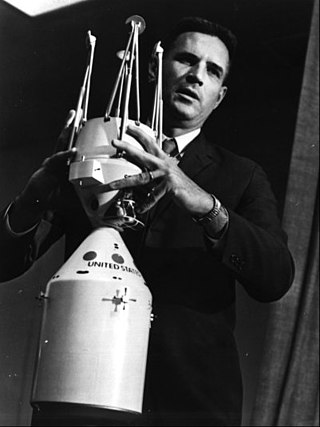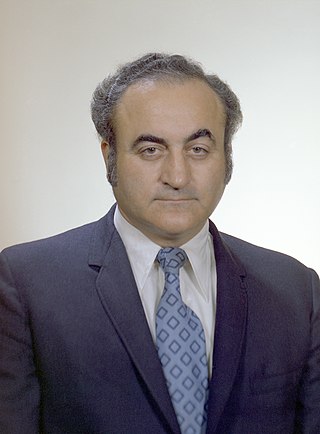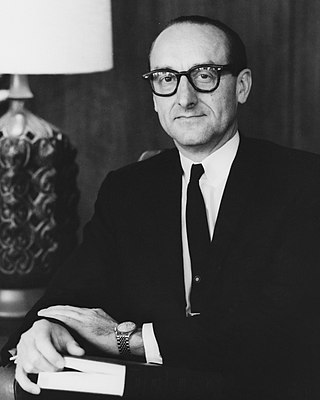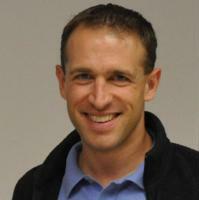Related Research Articles

The Apollo program, also known as Project Apollo, was the United States human spaceflight program carried out by the National Aeronautics and Space Administration (NASA), which succeeded in preparing and landing the first humans on the Moon from 1968 to 1972. It was first conceived in 1960 during President Dwight D. Eisenhower's administration as a three-person spacecraft to follow the one-person Project Mercury, which put the first Americans in space. Apollo was later dedicated to President John F. Kennedy's national goal for the 1960s of "landing a man on the Moon and returning him safely to the Earth" in an address to Congress on May 25, 1961. It was the third US human spaceflight program to fly, preceded by the two-person Project Gemini conceived in 1961 to extend spaceflight capability in support of Apollo.

The Lunar Roving Vehicle (LRV) is a battery-powered four-wheeled rover used on the Moon in the last three missions of the American Apollo program during 1971 and 1972. It is popularly called the Moon buggy, a play on the term "dune buggy".

The George C. Marshall Space Flight Center (MSFC), located in Redstone Arsenal, Alabama, is the U.S. government's civilian rocketry and spacecraft propulsion research center. As the largest NASA center, MSFC's first mission was developing the Saturn launch vehicles for the Apollo program. Marshall has been the lead center for the Space Shuttle main propulsion and external tank; payloads and related crew training; International Space Station (ISS) design and assembly; computers, networks, and information management; and the Space Launch System. Located on the Redstone Arsenal near Huntsville, MSFC is named in honor of General of the Army George C. Marshall.
The Saturn I was a rocket designed as the United States' first medium lift launch vehicle for up to 20,000-pound (9,100 kg) low Earth orbit payloads. The rocket's first stage was built as a cluster of propellant tanks engineered from older rocket tank designs, leading critics to jokingly refer to it as "Cluster's Last Stand". Its development was taken over from the Advanced Research Projects Agency in 1958 by the newly formed civilian NASA. Its design proved sound and flexible. It was successful in initiating the development of liquid hydrogen-fueled rocket propulsion, launching the Pegasus satellites, and flight verification of the Apollo command and service module launch phase aerodynamics. Ten Saturn I rockets were flown before it was replaced by the heavy lift derivative Saturn IB, which used a larger, higher total impulse second stage and an improved guidance and control system. It also led the way to development of the super-heavy lift Saturn V which carried the first men to landings on the Moon in the Apollo program.

The F-1, commonly known as Rocketdyne F-1, was a rocket engine developed by Rocketdyne. This engine uses a gas-generator cycle developed in the United States in the late 1950s and was used in the Saturn V rocket in the 1960s and early 1970s. Five F-1 engines were used in the S-IC first stage of each Saturn V, which served as the main launch vehicle of the Apollo program. The F-1 remains the most powerful single combustion chamber liquid-propellant rocket engine ever developed.

Voyage is a 1996 hard science fiction novel by British author Stephen Baxter. The book depicts a crewed mission to Mars as it might have been in another timeline, one where John F. Kennedy survived the assassination attempt on him on 22 November 1963. Voyage won a Sidewise Award for Alternate History, and was nominated for the Arthur C. Clarke Award in 1997.

Alexander A. McCool Jr. was manager of the Space Shuttle Projects Office at the NASA George C. Marshall Space Flight Center in Huntsville, Alabama. During his career, McCool contributed to several space developments including the Apollo Program, Skylab and the Space Shuttle program.

Glynn Stephen Lunney was an American NASA engineer. An employee of NASA since its creation in 1958, Lunney was a flight director during the Gemini and Apollo programs, and was on duty during historic events such as the Apollo 11 lunar ascent and the pivotal hours of the Apollo 13 crisis. At the end of the Apollo program, he became manager of the Apollo–Soyuz Test Project, the first collaboration in spaceflight between the United States and the Soviet Union. Later, he served as manager of the Space Shuttle program before leaving NASA in 1985 and later becoming a vice president of the United Space Alliance.

Joseph Francis Shea was an American aerospace engineer and NASA manager. Born in the New York City borough of the Bronx, he was educated at the University of Michigan, receiving a Ph.D. in Engineering Mechanics in 1955. After working for Bell Labs on the radio inertial guidance system of the Titan I intercontinental ballistic missile, he was hired by NASA in 1961. As Deputy Director of NASA's Office of Manned Space Flight, and later as head of the Apollo Spacecraft Program Office, Shea played a key role in shaping the course of the Apollo program, helping to lead NASA to the decision in favor of lunar orbit rendezvous and supporting "all up" testing of the Saturn V rocket. While sometimes causing controversy within the agency, Shea was remembered by his former colleague George Mueller as "one of the greatest systems engineers of our time".

Ernst Stuhlinger was a German-American atomic, electrical, and rocket scientist. After being brought to the United States as part of Operation Paperclip, he developed guidance systems with Wernher von Braun's team for the US Army, and later was a scientist with NASA. He was also instrumental in the development of the ion engine for long-endurance space flight, and a wide variety of scientific experiments.

Rocco Anthony Petrone was an American mechanical engineer, U.S. Army officer and NASA official. He served as director of launch operations at NASA's Kennedy Space Center (KSC) from 1966 to 1969, as Apollo program director at NASA Headquarters from 1969 to 1973, as third director of NASA's Marshall Space Flight Center from 1973 to 1974, and as NASA Associate Administrator from 1974 until his retirement from NASA in 1975.

George Edwin Mueller, was an American electrical engineer who was an associate administrator at NASA, heading the Office of Manned Space Flight from September 1963 until December 1969. Hailed as one of NASA's "most brilliant and fearless managers", he was instrumental in introducing the all-up testing philosophy for the Saturn V launch vehicle, which ensured the success of the Apollo program in landing a man on the Moon and returning him safely to the Earth by the end of 1969. Mueller also played a key part in the design of Skylab, and championed the Space Shuttle's development, which earned him the nickname, "the father of the Space Shuttle."

The Neutral Buoyancy Simulator was a neutral buoyancy pool located at NASA's George C. Marshall Space Flight Center (MSFC). Engineers and astronauts developed hardware and practiced procedures in this tank from its completion in 1968 through its decommissioning in 1997. Marshall recognized the need for underwater simulations of extra-vehicular activities (EVAs) and developed three successively larger tanks for the purpose. The Neutral Buoyancy Simulator contributed significantly to the American crewed space program. Skylab, the Space Shuttle, Hubble Space Telescope, and the International Space Station have all benefited from the Neutral Buoyancy Simulator. Until Johnson Space Center constructed the Weightless Environment Test Facility in the mid-1970s, MSFC had the only NASA-owned test facility that allowed engineers and astronauts to become familiar with the dynamics of body motion under weightless conditions.

The Saturn V dynamic test vehicle, designated SA-500D, is a prototype Saturn V rocket used by NASA to test the performance of the rocket when vibrated to simulate the shaking which subsequent rockets would experience during launch. It was the first full-scale Saturn V completed by the Marshall Space Flight Center (MSFC). Though SA-500D never flew, it was instrumental in the development of the Saturn V rocket which propelled the first men to the Moon as part of the Apollo program. Built under the direction of Dr. Wernher von Braun, it served as the test vehicle for all of the Saturn support facilities at MSFC.

Saturn V is a retired American super heavy-lift launch vehicle developed by NASA under the Apollo program for human exploration of the Moon. The rocket was human-rated, had three stages, and was powered with liquid fuel. Flown from 1967 to 1973, it was used for nine crewed flights to the Moon, and to launch Skylab, the first American space station.
Heinz-Hermann Koelle was a German aeronautical engineer who made the preliminary designs on the rocket that would emerge as the Saturn I. Closely associated with Wernher von Braun's team at the Army Ballistic Missile Agency (ABMA), he was a member of the launch crew on Explorer 1 and later directed the Marshall Space Flight Center's involvement in Project Apollo. In 1965, he accepted the Chair of Space Technology at the Technical University of Berlin.

Thomas Joseph O'Malley was an Irish-American aerospace engineer who, as chief test conductor for the Convair division of General Dynamics, was responsible for pushing the button on February 20, 1962, launching the Mercury-Atlas 6 space flight carrying astronaut John Glenn, the first American in orbit. Five years later, NASA asked North American Aviation to hire him as director of launch operations to help get the Apollo program back on track after the Apollo 1 command module fire on the launch pad killed three astronauts. O'Malley continued to play a leadership role in the United States' space program through the first Space Shuttle launch in 1981.

Christopher E. Gerty is an American aerospace engineer who worked on NASA's Constellation Program. Gerty is an advocate of NASA's Open Government Initiative and is a leading voice on the concept of participatory exploration and collaboration. He has fifteen years of experience working on complex, technology-intense projects at NASA. Gerty served as an aquanaut on the NASA Extreme Environment Mission Operations 13 crew.
Matthew Ondler is the CTO and Director of Spacecraft Development at Axiom Space. Axiom Space is building the world's first commercial space station. Shortly after Ondler joining Axiom Space, NASA announced the award of $140M contract to Axiom and the exclusive right for Axiom Space to build its space station off the forward port of the ISS. Previously he was the president and co-founder of Houston Mechatronics. Before that, he was the lead manager of the software, robotics, and simulation division of NASA's Johnson Space Center. Ondler earned his BS in Aerospace Engineering from the University of Colorado in Boulder, CO. He then moved to Houston, TX, where he began a 28 year career at NASA Johnson Space Center. While at NASA he achieved his MBA in Finance and Marketing from the University of Houston and completed the Senior Executive Fellows Program at Harvard University.

Mary Helen Johnston, later also Mary Helen McCay, is an American scientist and former astronaut. Working with NASA as an engineer in the 1960s and '70s, Johnston aspired to be an astronaut; she unsuccessfully applied in 1980 before becoming a payload specialist in 1983. Johnston retired from NASA in 1986 without having gone to space. She is a professor at Florida Institute of Technology.
References
- ↑ "Southern alum and professor recounts working on Apollo 11 mission". Southern University and A&M College. 2019-07-18. Retrieved 2020-06-25.
- 1 2 3 4 5 Ansberry, Clare (2019-07-15). "Reach for the Moon: Four Lives, the Space Race and a Chaotic Decade". Wall Street Journal. ISSN 0099-9660 . Retrieved 2020-06-26.
- 1 2 3 4 5 6 7 Paul, Richard. "How NASA Joined the Civil Rights Revolution". Air & Space Magazine. Retrieved 2020-06-26.
- 1 2 3 4 Lussier, Charles (2019-07-19). "Young black engineers from Southern University helped fill out 'road map' to the moon". The Advocate. Retrieved 2020-06-26.
- ↑ Paul, Richard (2016-01-15). "Race and the Space Race: the unlikely story of civil rights and the space program". PRX. Retrieved 2001-02-24.
- ↑ Shakerdge, Karen (2015-06-25). "New book documents NASA's 1961 civil rights mission". WHYY. Retrieved 2020-06-26.
- ↑ Deen, Lango (2019-07-12). "Trailblazing Black Engineers at NASA". US Black Engineer. Retrieved 2020-06-26.
- 1 2 3 4 Paul, Richard; Moss, Steven (2015-05-01). We Could Not Fail: The First African Americans in the Space Program. University of Texas Press. ISBN 978-0-292-77251-9.
- 1 2 3 4 Guillroy, Deon (2019-07-18). "From cotton fields to NASA: Southern alum and professor recounts working on Apollo 11 mission". BRProud.com. Retrieved 2020-06-26.